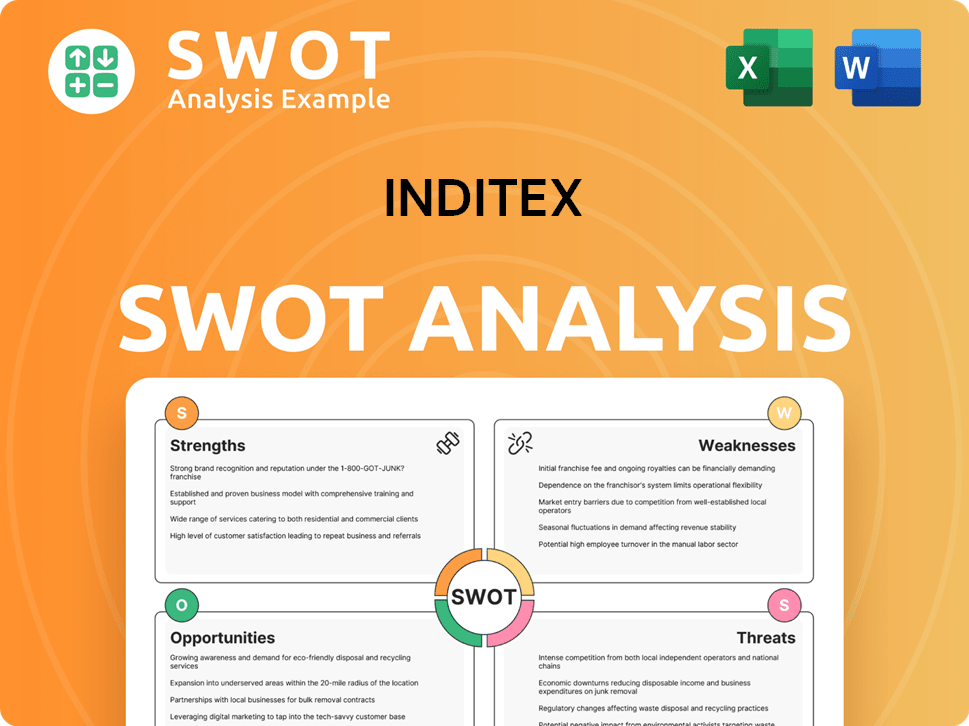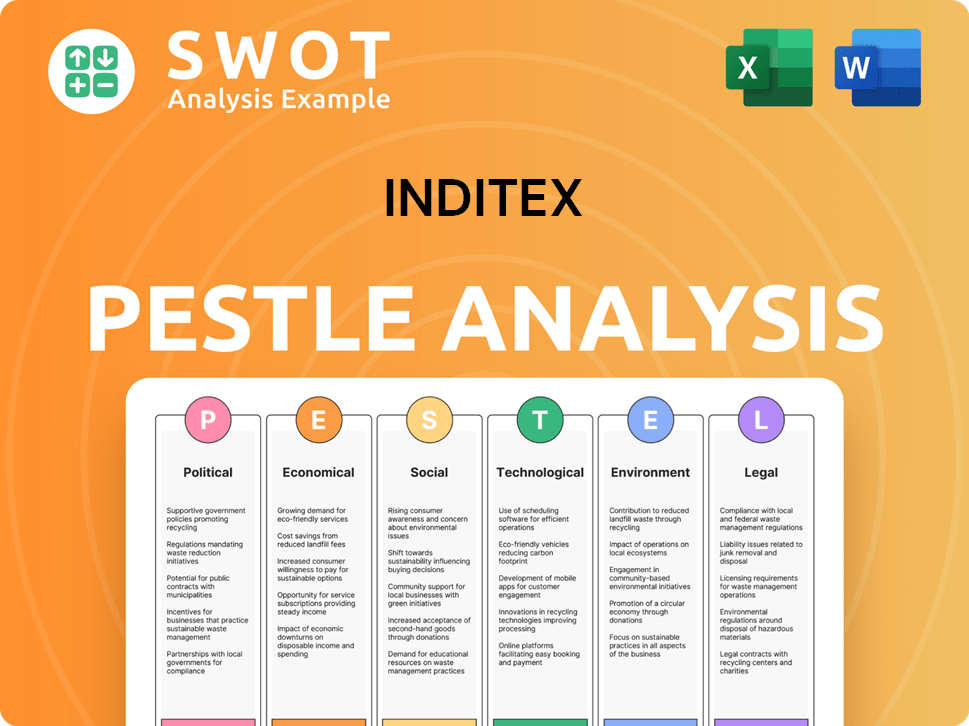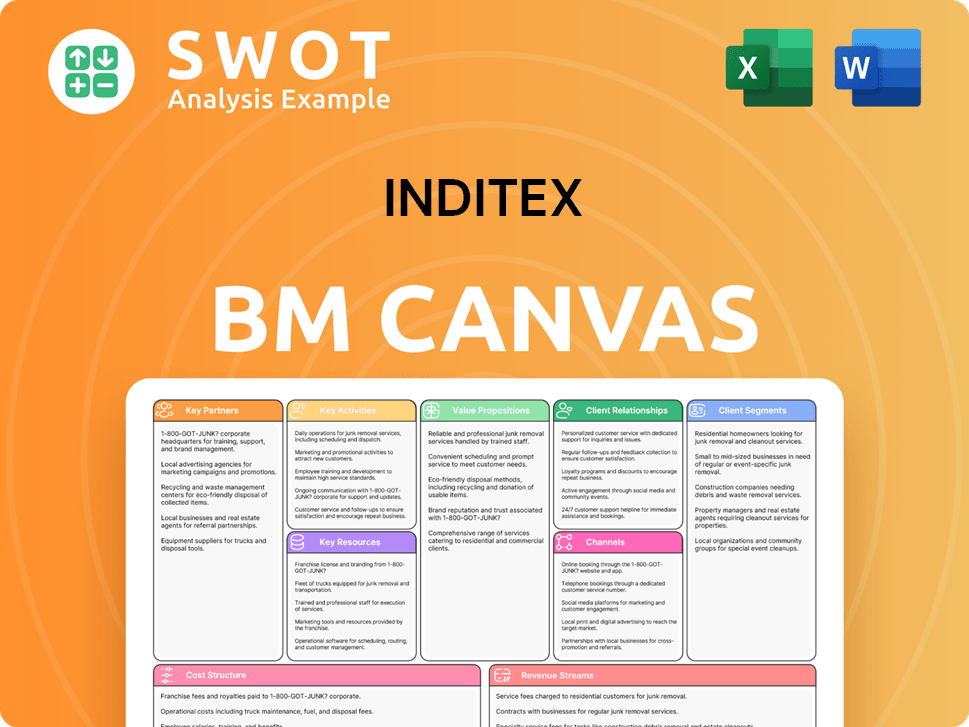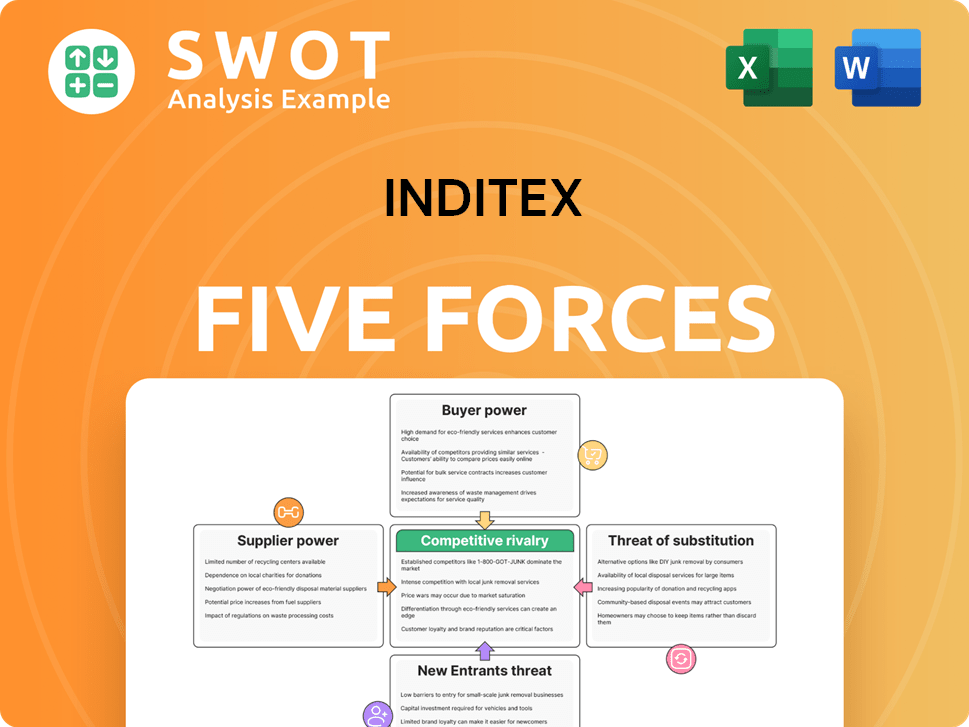Inditex Bundle
How Does Inditex Dominate the Global Fashion Stage?
Inditex, the Spanish fashion giant, isn't just a retailer; it's a trendsetter, a disruptor, and a financial powerhouse. Its rapid-fire fashion model, spearheaded by Zara, has redefined how clothes are designed, manufactured, and delivered to consumers. With record-breaking revenue in 2023, understanding the inner workings of the Inditex company is crucial for anyone interested in the fast fashion industry.

The Inditex business model, built on speed and responsiveness, allows it to swiftly adapt to changing consumer tastes and market dynamics. Its extensive brand portfolio, including Zara, Pull&Bear, and Bershka, caters to diverse demographics, solidifying its global presence. To further understand Inditex's strategic advantages, consider exploring an Inditex SWOT Analysis, which provides valuable insights into its strengths, weaknesses, opportunities, and threats, offering a comprehensive perspective on its market position and future prospects.
What Are the Key Operations Driving Inditex’s Success?
Inditex creates and delivers value through its vertically integrated business model. This approach allows for rapid design, production, and distribution of fashion apparel. The company's core products include a wide range of clothing, accessories, and homeware, catering to diverse customer segments through its distinct brands.
Zara, the primary brand, targets fashion-conscious consumers seeking trendy styles at accessible prices. Massimo Dutti appeals to a more classic and sophisticated demographic. The operational processes are characterized by speed and flexibility, which is a key element of the Inditex business model.
Unlike traditional fashion retailers, Inditex controls much of its supply chain, from design and manufacturing to logistics and sales. This vertical integration minimizes lead times, enabling the company to respond swiftly to emerging fashion trends and customer demand. The company leverages a sophisticated logistics network to ensure efficient product flow to its global network of stores and online platforms. Its sales channels include both physical stores and robust e-commerce platforms, providing a seamless shopping experience.
Inditex offers a diverse range of clothing, accessories, and homeware. The primary brand, Zara, focuses on trendy styles at accessible prices. Other brands cater to different customer segments, ensuring a broad market reach.
The company's operations are built on speed and flexibility. Vertical integration allows for quick responses to fashion trends. New designs can go from concept to store shelves in a matter of weeks.
Inditex controls a significant portion of its supply chain. This control minimizes lead times and enhances responsiveness. The logistics network ensures efficient distribution to stores and online platforms.
Inditex utilizes both physical stores and e-commerce platforms. This omnichannel approach provides a seamless shopping experience. The company focuses on providing convenience and accessibility to its customers.
Inditex's 'fast fashion' model prioritizes speed to market and continuous merchandise replenishment. This approach minimizes inventory risk and allows for rapid testing of new styles. The company's core capabilities translate into significant customer benefits.
- Offers fresh, on-trend fashion frequently.
- Achieves market differentiation through rapid product adaptation.
- Minimizes inventory risk.
- Enhances customer engagement through frequent new arrivals.
Inditex SWOT Analysis
- Complete SWOT Breakdown
- Fully Customizable
- Editable in Excel & Word
- Professional Formatting
- Investor-Ready Format

How Does Inditex Make Money?
The core of the Inditex business model revolves around generating revenue through the sale of fashion apparel, accessories, and homeware products. This is primarily achieved through a vast network of physical stores and a growing online presence. In fiscal year 2023, the company reported a total revenue of €35.9 billion, with the majority stemming directly from product sales.
Inditex's monetization strategy is built on high sales volumes, driven by its fast-fashion model. This model encourages frequent purchases due to the continuous introduction of new styles. The company's approach includes an omnichannel strategy, where online sales complement in-store purchases, providing multiple customer touchpoints and expanding its reach. The success of this strategy is evident in the growth of online sales, which reached €9.06 billion in fiscal year 2023, reflecting a 16% increase.
The company does not rely on subscription models, licensing, or advertising as primary revenue streams, focusing instead on the direct sale of its merchandise. Over time, Inditex has increasingly invested in its online capabilities, recognizing the shift in consumer shopping habits and expanding its revenue sources beyond traditional brick-and-mortar retail. Understanding the Growth Strategy of Inditex can provide further insights into its financial performance and expansion plans.
Inditex’s revenue streams are primarily from product sales through its global network of stores and online platforms. The fast-fashion model and the constant introduction of new styles encourage frequent purchases. Zara consistently contributes the largest share of revenue among its brands.
- Product Sales: The primary revenue source is the sale of apparel, accessories, and homeware across various brands.
- Omnichannel Approach: Integrating online and in-store sales to enhance customer reach and provide multiple shopping touchpoints.
- Fast-Fashion Model: Frequent introduction of new styles to drive sales and encourage repeat purchases.
- Online Sales Growth: Significant investment and expansion of online platforms to capitalize on changing consumer behaviors.
Inditex PESTLE Analysis
- Covers All 6 PESTLE Categories
- No Research Needed – Save Hours of Work
- Built by Experts, Trusted by Consultants
- Instant Download, Ready to Use
- 100% Editable, Fully Customizable

Which Strategic Decisions Have Shaped Inditex’s Business Model?
The journey of Inditex, a global leader in the fashion industry, has been marked by significant milestones and strategic decisions. The establishment of Zara in 1975 was a foundational moment, setting the stage for its innovative fast-fashion approach. The company's expansion into international markets during the 1980s and 1990s was crucial for its global dominance, shaping its Inditex's brief history.
Inditex's operational strategies have consistently evolved to meet challenges, including supply chain disruptions and changing consumer preferences. The COVID-19 pandemic, for instance, prompted the company to accelerate its digital transformation, focusing on e-commerce and optimizing logistics. This strategic shift has been successful, with online sales continuing to grow significantly, demonstrating the company's adaptability.
Inditex's competitive advantages are multifaceted, including its vertically integrated supply chain, strong brand portfolio (particularly Zara), and economies of scale. The company also leverages data analytics to understand consumer preferences and optimize inventory management. These factors contribute to Inditex's ability to quickly respond to market trends and maintain its position in the competitive fashion industry. Inditex continues to adapt to new trends, such as increased demand for sustainable fashion, by investing in more environmentally friendly materials and processes, reflecting its commitment to staying ahead in a dynamic industry.
The launch of Zara in 1975 was a pivotal moment, establishing the foundation for the fast-fashion model. Expansion into international markets in the 1980s and 1990s was crucial for global reach. The introduction of brands like Pull&Bear, Massimo Dutti, Bershka, and Stradivarius expanded its consumer base.
Inditex has consistently adapted to market changes, including the acceleration of its digital transformation during the COVID-19 pandemic. Investments in e-commerce and logistics optimization have been key. The company focuses on data analytics to understand consumer preferences and optimize inventory.
Inditex's vertically integrated supply chain allows for rapid response to trends. Its strong brand portfolio, particularly Zara, fosters customer loyalty. Economies of scale and data-driven inventory management contribute to cost efficiencies. The company is also investing in sustainable practices.
In fiscal year 2024, Inditex reported a net profit of €5.39 billion, a 10.7% increase. Sales reached €36.1 billion, reflecting strong growth across all regions. The company's online sales continued to increase, demonstrating the success of its digital strategy.
Inditex's success is built on its ability to quickly respond to fashion trends and consumer demands. Its vertically integrated model allows for rapid design, production, and distribution. The company's global presence and diverse brand portfolio contribute to its competitive edge, allowing it to cater to a wide range of consumers.
- Fast-fashion model with rapid inventory turnover.
- Strong brand recognition and customer loyalty, especially for Zara.
- Efficient supply chain management and logistics.
- Data-driven decision-making for inventory and marketing.
Inditex Business Model Canvas
- Complete 9-Block Business Model Canvas
- Effortlessly Communicate Your Business Strategy
- Investor-Ready BMC Format
- 100% Editable and Customizable
- Clear and Structured Layout

How Is Inditex Positioning Itself for Continued Success?
Inditex holds a significant position in the global fashion retail sector, consistently ranking among the top apparel companies. The company's brands, including Zara, enjoy high customer loyalty due to their trendy offerings and rapid product cycles. Inditex's extensive global reach, with a presence in over 200 markets, provides a strong competitive advantage.
However, Inditex faces various risks, including regulatory changes, intense competition from online retailers, and the growing demand for sustainable practices. Economic downturns and inflationary pressures can also impact consumer spending. Addressing these challenges requires continuous adaptation and strategic initiatives.
Inditex is a leading player in the fast fashion industry. Its market share is substantial, particularly in the fast-fashion segment. The company's diverse brand portfolio and global presence contribute to its strong industry position.
Key risks include regulatory changes concerning labor practices and environmental standards. Intense competition from online retailers and changing consumer preferences also pose challenges. Economic downturns and inflationary pressures can affect consumer spending on fashion apparel.
Inditex is focused on profitable growth, digital transformation, and international expansion. The company plans to invest significantly in its store and logistics network. Sustainability and innovation are key priorities for long-term success.
Inditex is committed to integrating sustainability into its operations, aiming for 100% of its products to be more sustainable by 2030. The company continues to invest in technology to enhance its online platforms and supply chain. Leadership emphasizes profitable growth and digital transformation.
Inditex's future outlook is centered on leveraging its agile Inditex business model, strong brand equity, and a commitment to innovation and sustainability. The company is focused on profitable growth, digital transformation, and international expansion. For example, Inditex plans to invest €1.8 billion in 2024 to optimize its store and logistics network, further enhancing its omnichannel capabilities. The company's strategic initiatives include a strong focus on sustainability, aiming for 100% of its products to be more sustainable by 2030. This commitment is crucial in an environment where consumers increasingly demand ethical and environmentally friendly practices, influencing Inditex's impact on the fashion industry.
- Sustainability: Aiming for 100% sustainable products by 2030.
- Digital Transformation: Enhancing online platforms and supply chain optimization.
- Expansion: Continued international growth and market penetration.
- Financial Performance: Focus on profitable growth and efficient operations. For more detailed information, you can read about the company's approach in the article: How does Inditex company work?
Inditex Porter's Five Forces Analysis
- Covers All 5 Competitive Forces in Detail
- Structured for Consultants, Students, and Founders
- 100% Editable in Microsoft Word & Excel
- Instant Digital Download – Use Immediately
- Compatible with Mac & PC – Fully Unlocked

Related Blogs
- What are Mission Vision & Core Values of Inditex Company?
- What is Competitive Landscape of Inditex Company?
- What is Growth Strategy and Future Prospects of Inditex Company?
- What is Sales and Marketing Strategy of Inditex Company?
- What is Brief History of Inditex Company?
- Who Owns Inditex Company?
- What is Customer Demographics and Target Market of Inditex Company?
Disclaimer
All information, articles, and product details provided on this website are for general informational and educational purposes only. We do not claim any ownership over, nor do we intend to infringe upon, any trademarks, copyrights, logos, brand names, or other intellectual property mentioned or depicted on this site. Such intellectual property remains the property of its respective owners, and any references here are made solely for identification or informational purposes, without implying any affiliation, endorsement, or partnership.
We make no representations or warranties, express or implied, regarding the accuracy, completeness, or suitability of any content or products presented. Nothing on this website should be construed as legal, tax, investment, financial, medical, or other professional advice. In addition, no part of this site—including articles or product references—constitutes a solicitation, recommendation, endorsement, advertisement, or offer to buy or sell any securities, franchises, or other financial instruments, particularly in jurisdictions where such activity would be unlawful.
All content is of a general nature and may not address the specific circumstances of any individual or entity. It is not a substitute for professional advice or services. Any actions you take based on the information provided here are strictly at your own risk. You accept full responsibility for any decisions or outcomes arising from your use of this website and agree to release us from any liability in connection with your use of, or reliance upon, the content or products found herein.